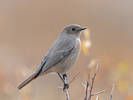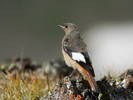search
classification
|
basic information
|
video
|
reports |
Guldenstadt's Redstart
Phoenicurus erythrogaster (Guldenstadt, 1775)

|
 male
|
|
|
2021-05-18
Tagarkhai village, Buryatia |
© Grigory Khasanov
|
|
Description
The male of the Guldenstadt's Redstart is colored very bright; it's plumage is sharply expressed by the three colors - black, bright-rufous and white. The most part of the back, the flanks of the head and neck, the throat, craw and the front part of the breast are black. The wings are dichromatic, black with the large white patches formed by the white color of the central part of the webs of the primaries and secondaries. The crown and scruff are white with light grey tinge in fresh plumage. The upper tail, tail feathers, abdomen and flanks are bright rufous. The legs and beak are black, the eyes are dark-brown. The female has the sandy-brown upper parts, flight feathers and the central pair of the tail feathers; darker on the back and lighter on the under parts. The uppertail and tail feathers except the central pair are light rufous. The juveniles in first plumage are dark brown with the small buffy washed mottles. The underparts are rufous-buffy with the dark brown tips of the feathers on the craw and breast. The males have large white patches on the growing flight feathers; the females have monochromatic brown flight feathers. Sizes. Wing 93,5-110,8 (males), 93,0-100,0 (females); tail 6,0-82,0; tarsus 24,3-31,0; beak 9,0-13,0 mm; weight 23-31 grams.
Biology
The Guldenstadt's Redstart is rare, in places common resident. It inhabits the alpine belt with the rocks and small patches of meadows or the constructions on 3000-4200 m in Tien Shan and on 2200-2700 m in Altai. On dispersals and in winter it visits the riparian forests (on 600-800 m) and foothills especially with the rich berry crop of barberry (Berberis sp.) and sea-buckthorn (Hippophae rhamnoides) which it eats on winter time. On breeding places it appears in mid-end April. Breeds in separate pairs quite far from each other. The nest is built by female (male escort her) in the rock cracks, between the stones or in the constructions (on any high-mountain stations) from the moss, dry grass and rootlets and is lined with plenty of feathers and some quantity of hair. Clutches of 3-4 white red mottled eggs is in May - early July. Only female incubates. Both parents feed juveniles fledged in the early – end June. After the fledging the male continues to feed juveniles for two or three weeks, while the female builds the new nest and incubates the second clutch. In Altai the brood of two full grown juveniles with male recorded on August 29 1984. The dates of the autumn dispersals are not well known. At the low altitudes and in the foothills Restarts appear after the strong snowfalls in the mountains; it may be in the end of September - October. Near Chilik several birds recorded January 15 2000.
References










